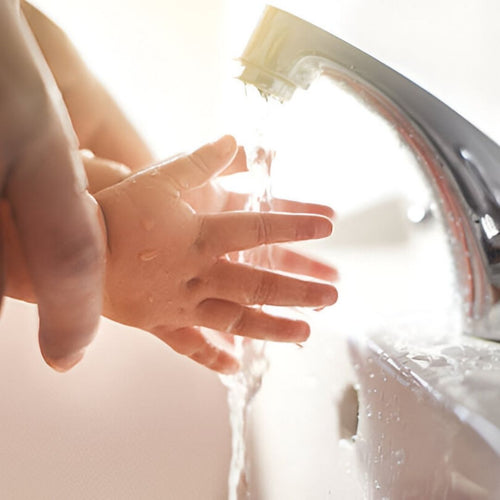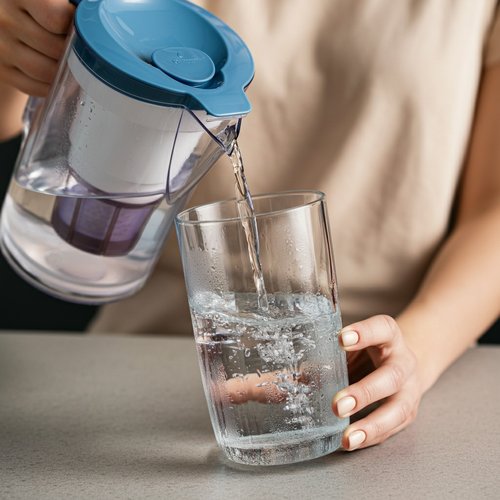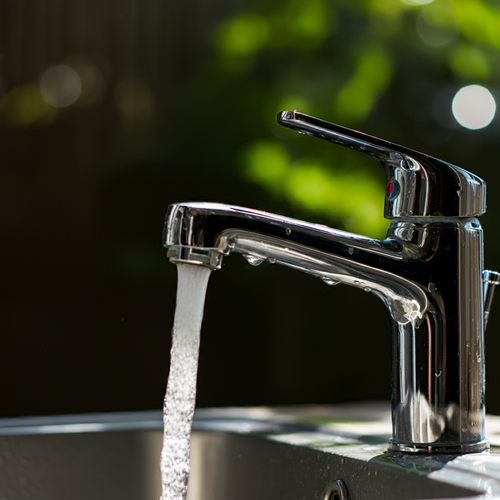Understanding Water Filtration
When we're thinking about keeping our water pure and safe, the basics of water filtration become a must-know. There are loads of ways to filter water out there, each tackling different bad stuff.
Knowing which is which helps us pick the best tool for the job, like getting rid of stuff we don't want, such as fluoride.
Basics of Water Filtration
Water filtration? It's about kicking unwanted stuff out of our water. Usually, it pulls the trick with methods that physically separate or chemically zap impurities. The whole point is to make sure the water we gulp down is squeaky clean.
Filtration maneuvers a few key tactics: screening, absorption, and adsorption. In a nutshell, screening sticks a barrier, like a mesh, in the way of big nasties like dirt. Absorption snags contaminants inside stuff, often carbon goodies.
Like, activated carbon is a champ at nixing yucky tastes and smells in tap water.
| Filtration Mechanism | Description |
|---|---|
| Screening | Stops bigger junk with a physical barricade |
| Absorption | Sucks up contaminants with materials like carbon |
| Adsorption | Grabs particles and holds them on surfaces |
Types of Water Filters
Water filters come in all shapes and sizes, each with a special job in mind. Let’s break ‘em down:
-
Activated Carbon Filters: These chipped carbon champs peel away chemicals, chlorine, and the chunky bits. They can cut down on up to 99% of solids and more. Even the EPA backs them for scrubbing out regular herbicides and pesticides.
-
Reverse Osmosis Filters: This one's like pushing water through a tight sieve to brush off impurities, fluoride included. These systems often team up with other methods for extra efficiency, but could be a hit to the wallet.
-
Screen-based Filters: Old-school method, using a mesh to trap dirt and grit.
-
Other Specialized Filters: Think ultra-filtration or ion exchange filters, zooming in on certain contaminants.
Picking the right filter is big time for nailing our water quality. Every type has its perks and quirks, so we’ve got to think about our own water needs when choosing the right fit for home use.
Activated Carbon Filters
Activated carbon filters are like the superheroes of water purification, swooping in to zap away those unwanted guests in our drinking supply. In this bit, let's figure out their superpowers and how they kick those nasty contaminants to the curb.
How Activated Carbon Filters Work
These crafty filters operate through a process known as adsorption, where they basically trap gunk by sticking it onto the carbon's surface. Imagine each granule having a surface so large, it could cover about 100 football fields.
Okay, maybe not literally, but that's how expansive the activated carbon is inside these filters.
As water hustles through, the filter acts like a magnet, attracting and snagging all sorts of impurities. The result? Cleaner, crisper water pouring out and into our glasses.
Contaminants Removed by Activated Carbon
These filters don’t just stop at contaminants—they make a pretty good effort at removing a range of pesky substances from our tap. Checked out by the Environmental Protection Agency (EPA) and NSF International, these filters can boot out 60 to 80 chemicals entirely, tamp down another 30, and even play a bit of a role with 22 more. Here's a rundown of what these filters get rid of:
| Contaminant Type | How Well They're Kicked Out |
|---|---|
| Total suspended solids | Up to 99% |
| Volatile organic compounds | Up to 99% |
| Chlorine and byproducts | 95% or more |
| Phosphates | Up to 90% |
| Pesticides and herbicides | 14 most common |
| PFAS (PFOS, PFNA) | Yep, it takes care of these! |
The EPA vouches for activated carbon filters because they can wipe out a good chunk of herbicides, pesticides, and other nasty stuff lurking in water. For those of us who give a darn about what's in our tap water, these filters might just be the hero we've been waiting for.
Fluoride Removal Methods
Ah, the quest for good, clean water. We all want to sip confidently from our tap, but when fluoride's in the mix, we need to know the best way to kick it out.
So, let's dig into more than just the usual charcoal filter spiel and uncover other promising techniques to tackle fluoride.
Effectiveness of Charcoal Filters
Charcoal filters, aka activated carbon filters, are the popular guys in town for trapping carbon-laced nasties like funky chemicals. But when fluoride tries to crash the party, things get a bit iffy.
You see, these filters are the friendly bouncers that let essential minerals (fluoride, calcium, magnesium, sodium) slip through the VIP line. While they can send some contaminants packing, fluoride often strolls right in.
Here's a quick look at what charcoal filters handle like pros and where they lag:
| Contaminant Type | Removal Efficiency |
|---|---|
| Total Suspended Solids | Up to 99% |
| Volatile Organic Compounds | Up to 99% |
| Heavy Metals | Variable |
| Fluoride | Minimal or None |
So, if fluoride's your main concern, sticking just a charcoal filter on might be like using a net to catch water.
Alternate Methods for Fluoride Removal
Now, for those of us determined to kick fluoride to the curb, check out these alternative routes that get the job done:
-
Reverse Osmosis: A super-efficient system that pushes water through a special membrane, knocking out 90 to 95% of that pesky fluoride and a bunch of other contaminants.
-
Distillation: Remember your fourth-grade science experiments? Distillation's like that. It boils water, catching steam and leaving junk like fluoride behind. Wicked effective but a bit of a slowpoke and energy hog.
-
Bone Char Activated Carbon: Not your everyday activated carbon—this one uses charred animal bones! It’s unique and zaps out around 85 to 95% of fluoride.
-
Alumina Adsorption: This guy uses activated alumina to send fluoride packing. When used right, it can reduce fluoride by a hefty 90%.
Here's how these methods stack up when it comes to fluoride:
| Method | Effectiveness |
|---|---|
| Activated Carbon | Minimal or None |
| Reverse Osmosis | 90-95% |
| Distillation | Very High |
| Bone Char Activated Carbon | 85-95% |
| Alumina Adsorption | 90% |
Armed with these options, we've got the info we need to keep our water pure. It's all about picking the method that best fits our needs and lifestyle preferences. Drink up, knowing what’s flowing from your tap!
Keeping Our Water Sparkling Clean
Being on top of water purity is a big deal when we want to keep our homes toxin and fluoride-free. As homeowners who care about what flows through our taps, checking out the right kinds of filter certifications and sticking to a maintenance routine will keep our water filter in prime shape.
Water Filter Certification Know-How
Picking a filter isn't as easy as choosing the one with the coolest design. We need to pay attention to certifications that guarantee it’s been properly vetted for doing the job. Some of the top displays of approval include:
| Certification | What It Means |
|---|---|
| NSF International | This badge shows the filter has been put through the wringer, checking for all sorts of nasties and ticking off health and safety tests. |
| Australian Standards Watermark | A tick from the Aussies, meaning it meets their strict rules for water safety and performance. |
A standout player like WFA struts their stuff with certifications from both NSF and the Aussie crew, making sure we get water that’s safe, smells fresh, and tastes just right.
Keeping Up with Filter Tune-Ups
Like any piece of gear, filters need some TLC to keep doing their thing. Here’s how often to refresh those parts:
| Part | Swap Out Timeline |
|---|---|
| Activated Carbon Filter | Every 6 to 12 months based on how hard it’s working and the gunk in the water. |
| Pre-filter (if you have one) | Every 3 to 6 months, to catch the really big stuff. |
| Reverse Osmosis Membrane | Switch it out every 2 to 3 years, depending on your setup. |
Got a charcoal filter? They're awesome at grabbing onto impurities like a magnet, but some sneaky ones like fluoride, sodium, and nitrates still slip through.
To catch these, we might need to throw in a mix like ion exchange, mechanical filtration, or reverse osmosis, custom-fitting it to work on the water quirks at our place.
By knowing what we're looking for in certifications and minding our filter upkeep, we can keep our water guzzling clean and yummy, sidestepping fluoride and other undesirables. Cheers to that!


















![Aldex Premium 10% Cross Link Resin for Water Softener [High Capacity]-SoftPro® Water Systems](http://www.softprowatersystems.com/cdn/shop/files/Aldex_10_Cross_Link_Resin_Premium_High_Capacity_for_Water_Softener_600x.jpg?v=1735853599)
























